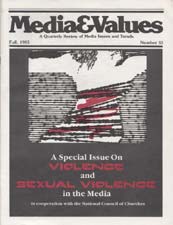MINORITIES: Who Commits Screen Sexual Violence?
|
This article originally appeared in Issue# 33
|
From an ethnic perspective, there is another dimension to the issue of sexual violence in the media. It is not just a question of what and how screen sexual violence occurs. It is also a question of who perpetrates that violence and against whom.
If a recent media feeding of sexual violence has affected contemporary viewers, how has a century-long diet of selected ethnic groups committing media sexual violence helped shape public beliefs and attitudes about those groups?
Black pimps beating up their prostitutes. Cartoonish super macho Hispanic men physically dominating the opposite sex. Ethnics of Eastern European origin brutalizing women in the finest Stanley Kowalski (A Streetcar Named Desire) tradition. And how about Italian Americans? Filmdom's La Mottas (Raging Bull), Corleones (The Godfather), and De Cocos (Bloodbrothers) come across as innately committed to continuous sex and violence, alone and in combination.
No doubt, sexual violence does occur within ethnic communities, as well as throughout the rest of American society. But the repeated, predictable, disproportionate media portrayal of ethnic sexual violence has inevitably contributed to stereotypical, distorted public views of ethnic life and people.
But there is something even more insidious – the conscious and unconscious media manipulation of interracial sexual violence. Since their early days, moviemakers have used sexually threatening "colored" ethnics to provoke and frighten "white" audiences. In the "greaser" westerns of the early l900s, swarthy Mexicans regularly menaced, kidnapped, and sexually threatened Anglo heroines. That threat was seldom consummated, since these heroines had to remain pure for their Anglo lovers, who rescued them in the nick of time and dispatched their primitive adversaries.
Screen stereotyping of sexually violent ethnics has worked emotionally for decades.
D.W. Griffith transformed this B-movie interracial manipulation into an art form with The Birth of a Nation, in which an Anglo heroine leaps from a cliff to her death rather than be touched by a lascivious black man. Particularly during the 1930s, Asian men sexually menaced white women, while the sexual fear of Japanese soldiers capturing American nurses provided knee-jerk emotions for such World War II movies as So Proudly We Hail. And for decades, Indians abducting white women served as stock fear-provokers in the typical Hollywood western.
American audiences, then, have been reared on media interracial sexual violence. Almost always it has been non-white men threatening and carrying out their threats against white women. For one brief, shining moment, as a corollary to the civil rights movement of the l960s, it appeared as if Hollywood might drop ethnic minorities as its sexual strawmen. Films challenged sexual guilt by reason of race (To Kill a Mockingbird), while interracial marriage even became acceptable (Guess Who's Coming to Dinner?), at least sort of. But the honeymoon was too good to last. Today, the cheap thrills and chills of interracial sexual violence, threatened or actual, have returned to the movie and TV screen. But now sex and violence is more graphic and even more gratuitous.
A black gang terrorizes Nancy Allen in a New York subway in Dressed to Kill. Kim Basinger tied to a pillar, surrounded by lusting Arabs, is saved from this fate worse than death by James Bond (Never Say Never Again). I am not accusing Hollywood of any plot against ethnic groups. Nor am I arguing that media-makers set out to "get" minority groups through depictions of interracial sexual violence. It is probably more a matter of entertainment industry sloth and socialization, blended with an absence of concern about the media's social impact.
Mediamakers know what grabs audiences, especially white audiences. Screen stereotyping of sexually violent ethnics has worked emotionally for decades. Why not rely on the tried and true? The only losers are the American people, who need greater interethnic understanding, not heightened fear of ethnic differences.



